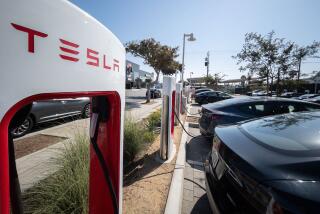Car review: 2014 BMW X5 versus Land Rover Sport in luxury SUV market
Think of mid-size luxury SUVs as a stable of thoroughbreds.
Porsche has its Cayenne, Mercedes-Benz its ML and GL, and Audi its Q7. The Japanese brands have their X models: Acura’s MDX, Lexus’ GX and Infiniti’s QX60.
For 2014, two redesigned purebreds join the mix: BMW’s third-generation X5, and Land Rover’s second-generation Range Rover Sport.
Each of the newcomers approaches this competitive segment — where prices range from $50,000 to $90,000 — with a different philosophy.
BMW’s X5 is the more practical of the two, setting aside style (inside and out) in favor of Bavarian functionality. Meanwhile, the Range Rover Sport makes a huge leap over its predecessor in refinement and performance.
Neither is cheap.
The base Range Rover Sport V-6 HSE we tested started at $63,495 but came to $72,425 at the checkout counter. Blame the $5,000 HSE package, a pricey but recommended set of options including Oxford leather seats, a panoramic moon roof and 20-inch wheels. An upgrade in stereo system and climate controlled seats made up the rest of the difference.
The six-cylinder BMW X5 xDrive35i starts at $56,025. But the model we tested rapidly made up the gap, finishing at $70,975. That included overpriced items such as keyless entry and soft-closing doors for $2,700 and a $1,900 lighting package.
Still, plenty of buyers are willing to part with that kind of money. The X5 and the Sport are the most popular sport utility vehicles for their respective brands in the U.S.
Within this lofty SUV realm, all competitors start with certain fundamentals, the X5 and the Sport included. Both offer a base six-cylinder engine and the option of a V-8, efficient transmissions and all-wheel drive. The second-generation Sport has a supercharged 3.0-liter V-6 engine good for 340 horsepower, 332 pound-feet of torque and a 6.9-second zero-to-60 mph time. The X5’s engine is a turbocharged, inline 3.0-liter unit capable of 302 horsepower, 295 pound-feet of torque and a 6.2-second zero-to-60 mph time.
It surprised us that the BMW smokes the Range Rover Sport by more than half a second. The two vehicles weigh within 60 pounds of each other, and the Sport felt faster in the never-reliable seat-of-the-pants test.
Both SUVs we tested use an eight-speed automatic transmission and full-time all-wheel drive to keep things moving. For buyers in warmer climes, far from the reach of any polar vortex, BMW now offers the rear-wheel-drive X5 sDrive 35i.
BMW wins the efficiency battle. The six-cylinder model we tested is rated at 18 mpg in city driving and 27 mpg on the highway. The V-6 Range Rover Sport comes in at 17 mpg in city driving and 23 mpg on the highway.
Credit that in part to the 170 pounds BMW shaved off the weight of the previous X5. But the Range Rover went on a much more drastic diet — losing 813 pounds through aluminum construction — so it’s surprising the Sport didn’t post better fuel economy numbers.
Without the extra pounds, the BMW and the Range Rover felt surprisingly agile for their size. But the Sport proved more fun to drive. On straights or through curves, it just felt more lively and eager — and quicker, even if acceleration times don’t show it.
Part of this handling prowess is related to another Range Rover advantage — its looks, much improved with a longer wheelbase. Although the Sport’s overall length grew just 2.5 inches, the wheelbase grew 7 inches, pushing the wheels more toward the corners of the vehicle. The result is a more athletic profile and better grip on the road.
The BMW’s design, by comparison, is more bland. It’s certainly handsome, and has a more crisp, modern look than it predecessor. But it lacks the visual panache of the Sport.
The Sport carries this gravitas inside too. With a design that slightly favors form over function, the Sport’s cabin is beautifully laid out. Everything you see and touch has a rich, opulent feel. You almost expect the person who slides into the perforated Oxford leather seat next to you to find your hair thicker, your teeth whiter, your waistline slimmer.
This Sport also trumped the Bimmer in terms of interior space, with more legroom throughout, more rear headroom and more cargo space with the seats up. Both models offer optional third-row seating, but neither of our test vehicles came so equipped.
The BMW’s innards are more practical. The standard navigation system has a larger screen, and it’s easier to use than the Range Rover’s. The iDrive rotary knob for the infotainment system has been updated to include a touch pad for easier entry of information.
The X5’s quality remains top-notch and feels as solid as any other BMW. But unlike the Range Rover, this interior didn’t feel as indulgent as you’d hope it would on a $70,000 vehicle.
It’s another small advantage for the Range Rover Sport, helping it win our comparison by a nose.
The BMW is a strong contender. But the Range Rover offers more to like, inside and out. And buyers look better driving it.
When you’re dropping $70,000 on an SUV, isn’t that the point?
david.undercoffler@latimes.com
Twitter @latimes_driven







